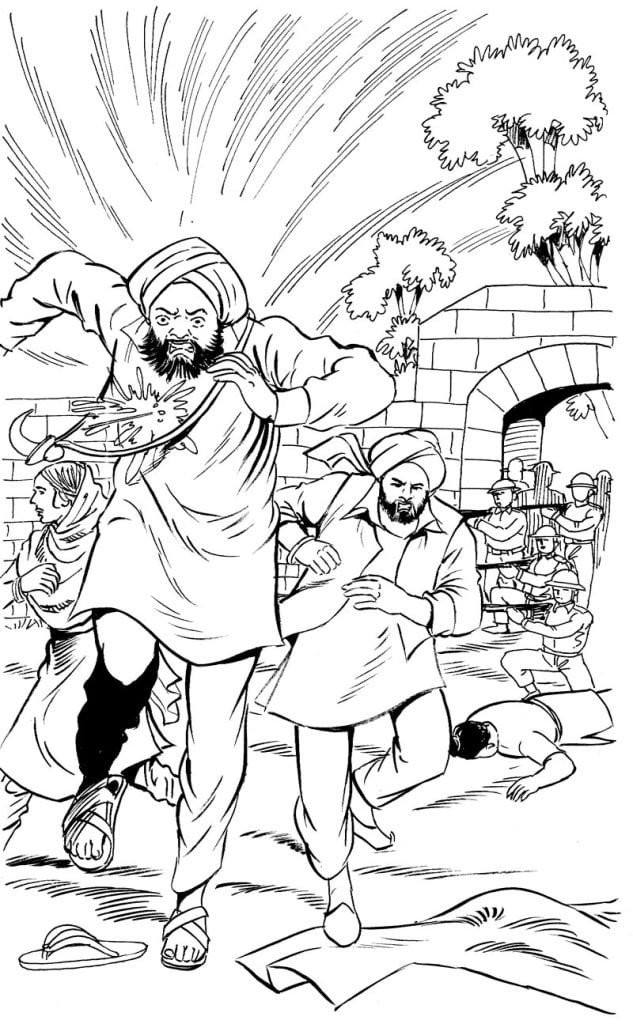Everything was going on smoothly. News of Civil Disobedience success were reaching from all over the country. But their was a minor confrontation took place in Delhi.
When Gandhiji received this news in Mumbai at once he set out for Delhi, but he was arrested in mid-way.
Mahadev Prasad forwarded this information to Rajendra Babu through a telegram. Rajendra Babu set out for Mumbai, but on way he got the news that unrest had started in Mumbai and Ahmedabad too.
On other side Gandhiji was released immediately after the arrest. He straight away went to Mumbai and from there alongwith Mahadev Desai set out for Ahmedabad.
After the arrival of Gandhiji Ahmedabad disturbance were pacified.
On April 13, 1919, Vaisakhi day—a meeting was held in Jalianwala Bagh at Amritsar. Its aim was to oppose the Rawlett Bill. In this meeting about 20 thousands men, women and children were present. This Bagh was surrounded by walls and there was only one exit which too was very narrow. So narrow even a vehicle could not enter inside from it.
Lala Hans Raj was addressing the meeting. Suddenly General O’Dier arrived there with armed soldiers. Those soldiers were British, who obstructed the way and started firing at innocent and peace loving people without any prior warning. There was a well inside the Bagh, people started jumping in it to save their lives. Hundreds were dead. Thousands wounded.

Even then General didn’t satisfy. He ordered to switch off power and water supplies.
This news was published in newspapers all over the country. At that time Gandhiji was in Mumbai. It created a surge of anger in the entire country. At that time Babu Rajendra Prasad was with Gandhiji. Gandhiji suspended Civil Disobedience movement due to this painful event. After Jalianwala Bagh tragedy Congress session was held in Amritsar in 1920. It was presided by Pt. Moti Lal Nehru. Being busy in court cases Rajendra Babu couldn’t participate in this session.
In the meantime British Government constituted a committee to investigate the atrocities in Punjab. But Congress did not agree to it and formed a separate committee for free and fair investigation and its report was published in 1920.
In the same year i.e. 1920 Congress session was held in Varanasi in which main issue was Jalianwala massare. Afresh Gandhiji put up the suggestion of Non-cooperation Movement which was seconded by all the leaders. Four main tasks of non-cooperation Movement were ascertained—1. Abandonment of government titles, 2. Boycott of govt. educational institutions 3. Settle legal issues out of courts, 4. Reconsteacion of State Councils.
Rajendra Babu was of the view that educational institutions should not reprobated in this way. Youth should be acknowledged about the deficiencies of education based on the Macauley’s education system.
In the meantime Majhrul Haque established a national school. Ram Kishore was appointed its headmaster, who returned from England at that time after passing M.A., Bar at Law. Gandhiji, Maulana Mohammed Ali and Maulana Azad came to Bihar.
Result of this movement was the formation of Kashi Vidyapeeth and Jamia Millia, Delhi.
At that time Rajendra Babu was the member of Senate and Syndicate of Patna University. Right then Sedlar Committee was formed for reforms in education in this university.
Rajendra Babu was in favour to keep mother tongue as medium of teaching at least up to matric standard. Several education officers and literate persons of Bihar were opposed this proposal, but a few British were in its favour. Ultimately the suggestion passed. Afterwards Rajendra Babu delinked himself with the university.
Bihar state assembly elections were due in November. Congress decided to boycott it. Rajendra Babu campaigned against it and addressed several meetings to boycott the election.
Till now Rajendra Babu had given up his advocacy.
In 1921 he visited Bihar and addressed rallies. His meeting were attended by people in large numbers. People listened to him attentively.
Once Rajendra Babu was in Agra. He received a notice there in which it was clearly written that every type of meeting or procession is banned in the city. Then Rajendra Babu went to a nearby village. A huge meeting was held there. He made a speech and returned to city after 5 p.m. There too a meeting was held.
In 1921 Congress session was to be held in Vijayawada. At that time Rajendra Babu was in Calcutta alongwith Gandhiji.
There occurred a severe famine in Orissa at that time. Gandhiji made a speech for the publicity of Charkha, boycott of foreign goods and extravagance etc. and called the people to serve the famine afflicted. After that he set out for Orissa. Babu Rajendra Prasad was also with him.
There used to be heavy rush at railway stations to welcome them. They reached Vijayawada by three
3 o’clock at night and to their surprise Diwali was being celebrated in the entire city.
Civil Disobedience Movement was on its full and government was busy in preparations to welcome Prince of Wales. The general Indian wants to oppose the Prince.
Meetings and protests marchs were organized. Firstly Ali brothers were arrested in Karachi. After that Chitaranjan Dass, Moti Lal Nehru, Jawahar Lal Nehru, Lala Lajpat Rai, Rajgopalachari too were arrested.
Then Rajendra Babu and others made an appeal to public not to join the govt. services. Rajendra Babu visited Bihar on returning to Patna after participated in Congress session at Ahmedabad.
During the visit when he was addressing a meeting at Puppri, he received a telegram of Gandhiji in which he was told to attend Congress Working Committee meeting at Bardoli
As Rajendra Babu received the information he set out for Bardoli.
At the same time Congress workers set a police station on fire in Chauri Chaura, in which several British policemen were killed. Gandhiji called off Civil Disobedience Movement due to this violence.
The movement was suspended. Govt. arrested Gandhiji and send him to Sabarmati prison. He was charged of writing inflammatory article in ‘Young India’. Gandhiji was imprisoned for six years.
When Rajendra Babu reached Sabarmati to meet Gandhiji, Gandhiji send him back after giving a few directions.

